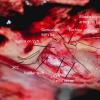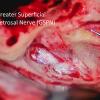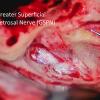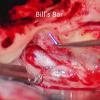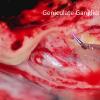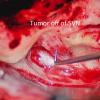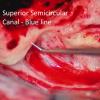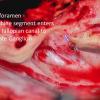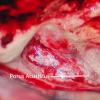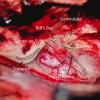Click on image above to enlarge; advance with cursor over border
return to: Otology Neurotology Protocols
OPERATIVE PROCEDURE
- Prep
-
Orders:
- Ancef, decadron - induction
- Mannitol - incision
- NIMs electrodes orbicularis oris and oculi - "Iowa Ear" setting on the console (0.05mA threshold)
- Hang notes, audio, consent
- Images up
- MRI - T1 post and CISS sequences
- Stenver's view (Gantz)
- scope should be set up for observer/assistant on same side as tumor (opposite other ear rooms - primary surgeon sits at head of patient)
-
find anesthetist to discuss:
- decadron (induction) & mannitol (incision)
- hypervent to ET of 28 until closing
- BP cuff & ETT contralateral to tumor
- no paralysis
- turn before A-line
- EAP monitor (Megan) - page 15m before needed (when start dissecting tumor).
- place skin electrodes & in-ear phones; 4 - one on each mastoid tip, trichion, vertex
- test ABR
- straps x3 - thumbs up
- do test roll
- Hansen likes foam rather than blankets for tucking
- Shave head - generous shave - (Hansen) ask if wanna keep side burn? up to widow’s peak
- Foley
-
- Incision and Elevation of Skin Flaps
- Gantz - Reverse question mark from tragus > up > 4-5 cm above helical root > curve to forehead; extend inferior leg posterior to tragus
- Hansen - same as above; extend inferior leg of incision anterior to auricle for few millimeters in some cases (to facilitate exposure of zygomatic root)
- Incise with 15 blade to level of TP fascia
- Elevate skin flap in plane of TP fascia. It is useful to wrap skin flap in moist raytech to prevent from dessication during case. Use tie-back suture to keep retracted out of your field
- Frontal branch - watch out for it
- In TP fascia proximally
- Deep to temporal fascia along zygomatic arch
- Fascia harvest
- Harvest small ~6x5cm piece of temporalis fascia to use in closure - leave 1cm rim of fascia along muscle edges to suture to later with closure (see image below, fascia already harvested)
- Incise the fascia sharply and dissect free of underlying muscle with scissors
- Muscle flap elevation
- Elevate the temporalis off of the calviarium using periosteal elevator. Again, wrap the muscle in moist raytech to protect from dessication, retract off field with stay suture.
- Creation of temporal craniotomy/bone flap
- Approximately 4x5cm bone flap centered over zygoma. Zygoma estimates level of floor of middle fossa
- Drill cortex with 5 cutter, bone wax as necessary for bleeding
- Bone will be thinner anteroinferiorly, thicker posteriorly
- Once dura is seen below a thin layer of bone, switch to a diamond burr so as not to injure dura
- Next, remove the bone flap and set aside for later
- Freshen the edges of the craniotomy with the diamond burr. Ideally, the inner and outer cortical tables should be parallel to keep the House-Urban retractor from shifting/rocking
- May need to ronguer excess bone, especially inferiorly, to achieve adequate access to the middle fossa floor
- Retract temporal lobe and place House-Urban retractor
- Bipolar cautery can be used judiciously to contract the dura and decrease the need for mechanical retraction
- Carefully dissect the dura off of the middle fossa floor in a posterior to anterior direction (prevents avulsion of the GSPN)
- Dissect dura off the GSPN taking care to leave nerve down while elevating dura up with temporal lobe
- The middle meningeal will come into view and may need to be cauterized to provide adequate exposure (this is anterior limit of exposure)
- Identify GSPN and arcuate eminence - IAC will bisect the angle formed by these two landmarks
- Place the blade of House-Urban under the lip of the petrous ridge and engage in the retractor *** (easier said than done)
- Expose internal auditory canal
- Drill to expose IAC in 270º
- Drill from medial to lateral - Bill's bar is lateral limit of dissection
- Identify SSSC as posterior limit of dissection - blue-line the canal
- Once dura is reached, thin the bone further until paper-thin
- Flick off shards of bone using 90º hook
- Tumor Removal
- Always dissect from medial to lateral
- Proximal labyrinthine portion of facial nerve is decompressed to allow for any swelling
- Inferior = Superior vestibular site of tumor origin
- Closure
- Irrigate and ensure hemostasis intracranially
- Place Oxycel or Avitene along the brainstem vasculature
- Dural repair (Gantz will use Tisseel, Hansen does not)
- IAC defect
- Gantz - prefers temporalis fascia and temporalis plug in petrous defect, no fat graft
- Hansen - prefers abdominal fat (harvested from left inferior quadrant, bikini line (lateral Pfannenstiel)), size of first thumb phalange - can later use fat sat imaging on surveillance MRI
- no penrose, close with Vicryl, monocryl and steristrips. Pressure dressing with elastoplast and fluffs
- Bone flap
- Resorb-X plating system (Hansen). Plates superior, posterior, anterior flap
- Skin/subcutaneous tissues
- Close the subcutaneous tissues with interrupted 3-0 vicryl sutures
- Gantz - Close skin with interrupted 3-0 nylon
- Hansen - Close skin with running/locking 3-0 nylon.
- Bulky mastoid-type dressing with adequate pressure to prevent spinal fluid subgaleal effusion from developing.
POSTOPERATIVE CARE
-
return to: Otology - Neurotology
Room Set-up
Patient images; Stenver view mastoid to assess bone thickness overlying superior canal; MRI coronal and axial (post-contrast) showing tumor and confirming operative side.
Patient clinic notes. Pre-operative note, audiogram, ABR test results and Internal medicine surgical co-management note placed on wall
White board: intra-operative medications. Nursing instructions to call family every 3 hours
ABR settings
Patient positioning with 3 point straps to allow rolling of the bed to improve operative exposure
Electrode placement; NIMS monitor electrodes in the orbicularis occuli and orbicularis oris with ground electrods on the chest; ABR click generator in the operertive side ear canal; 3 ABR electrodes (one on each mastoid and one on vertex). Also note the posteriorly based temporal skin flap design.
MODIFIED OPERATIVE PROCEDURE
Incision and Elevation of Skin Flaps
Two possible incision designs:
Anterior/inferiorly-based skin flap (MH)
Incision starts anterior to tragus, extends posteriorly approximately 3-4 cm posterior to pinna, superiorly 5-6 cm, and anteriorly again to the temporal hairline
Good for extended middle fossa approaches
Temporalis muscle is then reflected inferiorly
Posteriorly-based skin flap (BJG)
Incision starts just behind temporal hairline and a rounded box shape approx 6 cm wide is carried back approximately 6-7 cm.
Begin as low onto pinna as possible
Temporalis muscle flap is then reflected anteriorly
Keep temporoparietal fascia layer attached to scalp during skin flap elevation
Harvest a large piece of temporalis fascia prior to elevation of the muscle flap
leave cuff of fascia on either side of muscle flap
Elevate muscle flap
Anterior temporalis flap if posterior-based skin flap
Inferiorly-based temporalis flap if anterior-based skin flap
Should be able to see zygomatic root easily after elevation
Craniotomy
Anesthesiologist may administer mannitol
Consider hyperventilating patient
Center craniotomy on zygomatic root
4.5 x 4.5 cm wide bone flap
Use a 4 mm (BJG) or 5 mm (MRH) cutting burr to remove the majority of the bone.
Use diamond 4 mm burr, to remove the final layer of bone over the dura.
Branches of the middle meningeal artery will be encountered, which are controlled with bone wax or bipolar cautery
Mark bone flap to ensure easy and properly oriented replacement at end of case.
Elevate bone flap off of dural with Joker elevator.
Pass bone flap off to scrub nurse
Keep bone flap moist
Check exposure: if the bone window is not flush with the tegmen, remove excess bone with rongeur or drill
Dural Elevation
Circumferentially elevate the dura from the overlying cranium, using the bipolar cautery liberally to stop bleeding from the dura.
Place Oxycel cigars under the bone flap anteriorly, posteriorly, and superiorly.
Elevate the dura along the floor of the middle cranial fossa from posterior to anterior so as not to disrupt the greater superficial petrosal nerve (GSPN). (SEE FIGURE)
Identify the arcuate eminence, GSPN, and petrous ridge.
Use cottonoids anteriorly and posteriorly for dural retraction during elevation.
Brisk bleeding from the middle meningeal artery at the foramen spinosum may be encountered and can be controlled with bone wax and Oxycel packing.
Place the House-Urban retractor under the lip of the petrous ridge at the anticipated location of the IAC (based upon the arcuate eminence).
Identification of the IAC
Begin drilling using a 4-0 diamond burr over the arcuate eminence to identify the location of the superior semicircular canal.
The SSCC will be perpendicular to the petrous ridge
The Stenvers x-ray will demonstrate the amount of bone overlying the semicircular canal (SSCC).
Blueline the superior canal.
The IAC is located 60° anterior to the blue lined SSCC. (SEE FIGURE)
Lower the meatal plane over the IAC until it is well-defined
Tumor exposure
Drill deep troughs 270 degrees around the IAC, down to the level of the posterior fossa dura
Develop your exposure working medial to lateral
Exercise caution when drilling laterally, due to the location of the cochlea and ampulla of the SSCC.
Skeletonize the IAC up the level of Bill’s Bar.
Identify the labyrinthine segment of the facial nerve at the transverse crest and decompress the meatal foramen a few millimeters.
The cochlea is deeper than the plane of the labyrinthine segment of the facial nerve.
May avoid drilling deep to the facial nerve anteriorly to decrease risk of violating the cochlea
Remove the last flecks of bone from the IAC dura.
Have audiologist start monitoring ABR
Tumor Removal
Open the dura of the IAC over the superior vestibular nerve with a 59-10 Beaver blade or 2.5 mm hook.
Place a direct auditory nerve electrode between the dura of the IAC and the cochlear nerve for monitoring the cochlear action potentials in real time.
Identify the separation between the facial nerve and superior vestibular nerve at the transverse crest.
Separate the facial nerve from the superior and inferior vestibular nerves at this location.
Avulse lateral ends of the vestibular nerves, and reflect medially.
Use a 2.5 mm hook to separate the tumor from the facial and cochlear nerves.
Work from medial to lateral when possible.
When tumor has been separated, cut the medial ends of the vestibular nerves along with the tumor, thus removing the tumor.
Special considerations
In larger tumors, it is often necessary to debulk the tumor as for TL excision, prior to establishing a plane between the facial nerve and the tumor.
If the auditory response demonstrates prolongation of latency or a decrease in amplitude, switch strategies or pause tumor dissection for several minutes.
A cochlear nerve that no longer responds intraoperatively may still have hearing postoperatively, the reverse may be true.
Closure
Ensure hemostasis in IAC/CPA
Document stimulation of facial nerve with Prass Probe on 0.05 mAmp
Document ABR/Direct Nerve Monitoring after tumor removal
Repairing temporal bone defect
Apply bone wax to all opened air cells.
Place a large temporalis muscle plug (BJG) or abdominal fat (MRH) in the IAC defect.
Place the previously harvested fascia over the entire temporal bone defect.
Use the anterior corner of the bone flap, or a piece of the inner table, over the defect to prevent temporal lobe herniation into the middle ear, if exposed.
Bolster fascia into place with Oxycel ™ cigar
Tisseal ™ is optional to further secure fascia
Craniotomy closure
Release the House-Urban retractor and allow the temporal lobe to re-expand.
Relay to anesthesiologist that the EtCO2 can be allowed to rise
Ensure an accurate neuro pattie count.
Tack dura to pericranium with at least two 4-0 neurolon sutures to eliminate epidural potential space
Double check epidural hemostasis
Replace the bone flap.
Simply replace and allow to float (BJG)
Plate back with three plates (superior, anterior, posterior) reabsorbable system (MRH)
Close the temporalis muscle with water-tight interrupted 3-0 vicryl sutures.
Close the subcutaneous layer with water-tight interrupted 3-0 vicryl sutures.
Close the skin with running-locking 3-0 nylon sutures.
Place a large, tight mastoid dressing centered over surgical area.
For POSTOPERATIVE CARE , see Skullbase Post-Operative Care Map
CPT CODING
Middle cranial fossa approach
Intradural removal of tumor
Use of Operating Microscope
Facial Nerve Monitoring
( <5 cm2) or 62141 ( > 5 cm2) cranioplasty
Abdominal fat harvest
*Audiologists bill and code the ABR monitoring separately*
REFERENCES
Gantz BJ. Middle Cranial Fossa Technique lecture slides
Chen DA, Arriaga MA, Fukushima T. Technical refinements in retraction for middle fossa surgery. Am J Otol. 1998;19:208-211.
Gantz BJ, Harker LA, Parnes LS, McCabe BF. Middle cranial fossa Acoustic neuroma excision: results and complications. Ann Otol Rhinol Laryngol. 1986;95:454-459.
Nadol JB. Cerebellopontine angle tumors. In: Nadol JB, Schuknecht HF, eds. Surgery of the Ear and Temporal Bone. New York, NY. Raven Press, Ltd. 1993:391-413.
Weber PC, Gantz BJ. Results and complications from acoustic neuroma excision via middle cranial fossa approach. Am J Otol. 1996;17:669-675.
